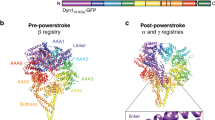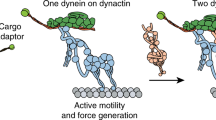Abstract
Cytoplasmic dynein is an AAA+ motor responsible for intracellular cargo transport and force generation along microtubules (MTs). Unlike kinesin and myosin, dynein contains multiple ATPase subunits, with AAA1 serving as the primary catalytic site. ATPase activity at AAA3 is also essential for robust motility, but its role in dynein's mechanochemical cycle remains unclear. Here, we introduced transient pauses in Saccharomyces cerevisiae dynein motility by using a slowly hydrolyzing ATP analog. Analysis of pausing behavior revealed that AAA3 hydrolyzes nucleotide an order of magnitude more slowly than AAA1, and the two sites do not coordinate. ATPase mutations to AAA3 abolish the ability of dynein to modulate MT release. Nucleotide hydrolysis at AAA3 lifts this 'MT gate' to allow fast motility. These results suggest that AAA3 acts as a switch that repurposes cytoplasmic dynein for fast cargo transport and MT-anchoring tasks in cells.
This is a preview of subscription content, access via your institution
Access options
Subscribe to this journal
Receive 12 print issues and online access
$189.00 per year
only $15.75 per issue
Buy this article
- Purchase on Springer Link
- Instant access to full article PDF
Prices may be subject to local taxes which are calculated during checkout







Similar content being viewed by others
References
Roberts, A.J., Kon, T., Knight, P.J., Sutoh, K. & Burgess, S.A. Functions and mechanics of dynein motor proteins. Nat. Rev. Mol. Cell Biol. 14, 713–726 (2013).
Hendricks, A.G., Holzbaur, E.L.F. & Goldman, Y.E. Force measurements on cargoes in living cells reveal collective dynamics of microtubule motors. Proc. Natl. Acad. Sci. USA 109, 18447–18452 (2012).
Dixit, R., Ross, J.L., Goldman, Y.E. & Holzbaur, E.L.F. Differential regulation of dynein and kinesin motor proteins by tau. Science 319, 1086–1089 (2008).
Laan, L. et al. Cortical dynein controls microtubule dynamics to generate pulling forces that position microtubule asters. Cell 148, 502–514 (2012).
Stokin, G.B. & Goldstein, L.S.B. Axonal transport and Alzheimer's disease. Annu. Rev. Biochem. 75, 607–627 (2006).
Kardon, J.R. & Vale, R.D. Regulators of the cytoplasmic dynein motor. Nat. Rev. Mol. Cell Biol. 10, 854–865 (2009).
Gennerich, A., Carter, A.P., Reck-Peterson, S.L. & Vale, R.D. Force-induced bidirectional stepping of cytoplasmic dynein. Cell 131, 952–965 (2007).
Reck-Peterson, S.L. et al. Single-molecule analysis of dynein processivity and stepping behavior. Cell 126, 335–348 (2006).
DeWitt, M.A., Chang, A.Y., Combs, P.A. & Yildiz, A. Cytoplasmic dynein moves through uncoordinated stepping of the AAA+ ring domains. Science 335, 221–225 (2012).
Vallee, R.B., McKenney, R.J. & Ori-McKenney, K.M. Multiple modes of cytoplasmic dynein regulation. Nat. Cell Biol. 14, 224–230 (2012).
McKenney, R.J., Vershinin, M., Kunwar, A., Vallee, R.B. & Gross, S.P. LIS1 and NudE induce a persistent dynein force-producing state. Cell 141, 304–314 (2010).
McKenney, R.J., Huynh, W., Tanenbaum, M.E., Bhabha, G. & Vale, R.D. Activation of cytoplasmic dynein motility by dynactin-cargo adapter complexes. Science 345, 337–341 (2014).
Schlager, M.A., Hoang, H.T., Urnavicius, L., Bullock, S.L. & Carter, A.P. In vitro reconstitution of a highly processive recombinant human dynein complex. EMBO J. 33, 1855–1868 (2014).
Mocz, G. & Gibbons, I.R. Model for the motor component of dynein heavy chain based on homology to the AAA family of oligomeric ATPases. Structure 9, 93–103 (2001).
Kon, T. et al. The 2.8 Å crystal structure of the dynein motor domain. Nature 484, 345–350 (2012).
Schmidt, H., Gleave, E.S. & Carter, A.P. Insights into dynein motor domain function from a 3.3-Å crystal structure. Nat. Struct. Mol. Biol. 19, 492–497 (2012).
Burgess, S.A., Walker, M.L., Sakakibara, H., Knight, P.J. & Oiwa, K. Dynein structure and power stroke. Nature 421, 715–718 (2003).
Imamula, K., Kon, T., Ohkura, R. & Sutoh, K. The coordination of cyclic microtubule association/dissociation and tail swing of cytoplasmic dynein. Proc. Natl. Acad. Sci. USA 104, 16134–16139 (2007).
Kon, T., Nishiura, M., Ohkura, R., Toyoshima, Y.Y. & Sutoh, K. Distinct functions of nucleotide-binding/hydrolysis sites in the four AAA modules of cytoplasmic dynein. Biochemistry 43, 11266–11274 (2004).
Silvanovich, A., Li, M.-G., Serr, M., Mische, S. & Hays, T.S. The third P-loop domain in cytoplasmic dynein heavy chain is essential for dynein motor function and ATP-sensitive microtubule binding. Mol. Biol. Cell 14, 1355–1365 (2003).
Roberts, A.J. et al. AAA+ ring and linker swing mechanism in the dynein motor. Cell 136, 485–495 (2009).
Kon, T., Mogami, T., Ohkura, R., Nishiura, M. & Sutoh, K. ATP hydrolysis cycle–dependent tail motions in cytoplasmic dynein. Nat. Struct. Mol. Biol. 12, 513–519 (2005).
Kon, T. et al. Helix sliding in the stalk coiled coil of dynein couples ATPase and microtubule binding. Nat. Struct. Mol. Biol. 16, 325–333 (2009).
Carter, A.P. et al. Structure and functional role of dynein's microtubule-binding domain. Science 322, 1691–1695 (2008).
Roberts, A.J. et al. ATP-driven remodeling of the linker domain in the dynein motor. Structure 20, 1670–1680 (2012).
Cho, C., Reck-Peterson, S.L. & Vale, R.D. Regulatory ATPase sites of cytoplasmic dynein affect processivity and force generation. J. Biol. Chem. 283, 25839–25845 (2008).
Ross, J.L., Wallace, K., Shuman, H., Goldman, Y.E. & Holzbaur, E.L. Processive bidirectional motion of dynein–dynactin complexes in vitro. Nat. Cell Biol. 8, 562–570 (2006).
Moffitt, J.R. et al. Intersubunit coordination in a homomeric ring ATPase. Nature 457, 446–450 (2009).
Cleary, F.B. et al. Tension on the linker gates the ATP-dependent release of dynein from microtubules. Nat. Commun. 5, 4587 (2014).
Chemla, Y.R. et al. Mechanism of force generation of a viral DNA packaging motor. Cell 122, 683–692 (2005).
Sen, M. et al. The ClpXP protease unfolds substrates using a constant rate of pulling but different gears. Cell 155, 636–646 (2013).
Guydosh, N.R. & Block, S.M. Backsteps induced by nucleotide analogs suggest the front head of kinesin is gated by strain. Proc. Natl. Acad. Sci. USA 103, 8054–8059 (2006).
Chistol, G. et al. High degree of coordination and division of labor among subunits in a homomeric ring ATPase. Cell 151, 1017–1028 (2012).
Gibbons, I.R. et al. The affinity of the dynein microtubule-binding domain is modulated by the conformation of its coiled-coil stalk. J. Biol. Chem. 280, 23960–23965 (2005).
Glynn, S.E., Martin, A., Nager, A.R., Baker, T.A. & Sauer, R.T. Structures of asymmetric ClpX hexamers reveal nucleotide-dependent motions in a AAA+ protein-unfolding machine. Cell 139, 744–756 (2009).
Carter, A.P., Cho, C., Jin, L. & Vale, R.D. Crystal structure of the dynein motor domain. Science 331, 1159–1165 (2011).
Zhang, X. et al. Structure of the AAA ATPase p97. Mol. Cell 6, 1473–1484 (2000).
Lee, S. et al. The structure of ClpB: a molecular chaperone that rescues proteins from an aggregated state. Cell 115, 229–240 (2003).
Yi, J.Y. et al. High-resolution imaging reveals indirect coordination of opposite motors and a role for LIS1 in high-load axonal transport. J. Cell Biol. 195, 193–201 (2011).
Huang, J., Roberts, A.J., Leschziner, A.E. & Reck-Peterson, S.L. Lis1 acts as a “clutch” between the ATPase and microtubule-binding domains of the dynein motor. Cell 150, 975–986 (2012).
Markus, S.M., Kalutkiewicz, K.A. & Lee, W.L. She1-mediated inhibition of dynein motility along astral microtubules promotes polarized spindle movements. Curr. Biol. 22, 2221–2230 (2012).
Firestone, A. J. et al. Small-molecule inhibitors of the AAA+ ATPase motor cytoplasmic dynein. Nature 484, 125–129 (2012).
Banaszynski, L.A., Liu, C.W. & Wandless, T.J. Characterization of the FKBP.rapamycin.FRB ternary complex. J. Am. Chem. Soc. 127, 4715–4721 (2005).
Kliegman, J.I. et al. Chemical genetics of rapamycin-insensitive TORC2 in S. cerevisiae. Cell Reports 5, 1725–1736 (2013).
Yildiz, A., Tomishige, M., Vale, R.D. & Selvin, P.R. Kinesin walks hand-over-hand. Science 303, 676–678 (2004).
Aitken, C.E., Marshall, R.A. & Puglisi, J.D. An oxygen scavenging system for improvement of dye stability in single-molecule fluorescence experiments. Biophys. J. 94, 1826–1835 (2008).
Rasnik, I., McKinney, S.A. & Ha, T. Nonblinking and long-lasting single-molecule fluorescence imaging. Nat. Methods 3, 891–893 (2006).
Hohng, S. & Ha, T. Near-complete suppression of quantum dot blinking in ambient conditions. J. Am. Chem. Soc. 126, 1324–1325 (2004).
Kingsley-Hickman, P.B. et al. Phosphorus-31 NMR studies of ATP synthesis and hydrolysis kinetics in the intact myocardium. Biochemistry 26, 7501–7510 (1987).
Acknowledgements
We are grateful to S. Can and J. Bandaria for critical reading of this manuscript and C. Slack and A. Truxal for help with NMR spectroscopy. This work was supported by the US National Institutes of Health (GM094522 (A.Y.) and training grant 5T32GM007232-38 (C.A.C.)), a US National Science Foundation CAREER Award (MCB-1055017 (A.Y.)) and a Graduate Research Fellowship (DGE 1106400 (F.B.C.)), and the Burroughs Wellcome Foundation (A.Y.).
Author information
Authors and Affiliations
Contributions
M.A.D. and A.Y. designed experiments, M.A.D. and C.A.C. performed single-molecule inhibition assays, M.A.D. and V.B. collected and performed single-molecule motility assays, M.A.D. performed bulk ATPase assays, F.B.C. performed optical-trapping assays and monomer release assays, M.A.D., C.A.C. and F.B.C. analyzed the data, and M.A.D. and A.Y. wrote the manuscript.
Corresponding author
Ethics declarations
Competing interests
The authors declare no competing financial interests.
Integrated supplementary information
Supplementary Figure 1 The AAA3 Walker loops are conserved in cytoplasmic but not axonemal or IFT dyneins.
Amino acid sequence alignment of cytoplasmic, axonemal, and IFT dynein AAA3 Walker A loops (GXXXXGKT). All cytoplasmic dyneins have a canonical Walker B loop (hhhhDE, h is hydrophobic), while axonemal and IFT dyneins have an E-to-D mutation, or a polar residue in the most N-terminal position. It is possible that AAA3 is only ATPase-active in cytoplasmic dyneins.
Supplementary Figure 2 Linear fits to force-dependent MT release rates of WT and AAA3 mutants.
Fits and their values are shown for (a) WT at 0 mM ATP and (b) AAA3E/Q at 2 mM ATP for plus-end directed (left) and minus-end directed (right) force. The results of WT monomers are from Reference 5.
Supplementary Figure 3 Run lengths of WT and AAA3K-A decrease as a function of added salt.
AAA3K/A remains processive at high salt concentrations (up to 200 mM) relative to WT.
Supplementary Figure 4 Pause density analysis of WT under different ATPγS concentrations.
(a) Representative traces with residence time histograms of WT at 1 mM ATP and 0, 12 and 100 μM ATPγS. In the absence of ATPγS, the WT dynein moves rapidly down the MT at near constant velocity, with a short residence time in each 50 nm bin. At 12 μM ATPγS, pauses become evident in the trace, and are reflected by clusters of high residence time. At 100 μM (saturating) ATPγS, the motor is paused the majority of the time, and approximately half the bins have a residence time higher than 3 s. (b) The residence time histogram of WT per 50 nm. In the absence of ATPγS, the motor is in a “fast” state taking τ1 = 0.37 s on average to travel 50 nm along the MT. Addition of ATPγS reveals a second population with a longer residence time (τ2 = 3.18 s), referred to as the “paused” state. Each histogram was fitted with biexponential decay (red curve). The amplitudes (a1 and a2) and characteristic residence times (τ1 and τ2) are used to calculate the PD. The paused population is nearly non-existent at 0 µM. There is a significant sub-population of paused motors at 12 and 40 µM ATPγS. Despite a further 2.5-fold increase in ATPγS concentration to 100 µM, the PD is not substantially increased over the 40 µM condition, indicating that the inhibitor is nearly saturating at 100 µM.
Supplementary Figure 5 WT dynein shows signs of complex (> two-state) inhibition by ATPγS.
(a) Histograms of velocities measured at 1 second intervals for 1 mM ATP and 0, 2, and 20 µM ATPγS. The velocity decreases as ATPγS concentration increases. Note the presence of an intermediate population of motors in the 2 µM ATPγS case at ~40 nm/s (arrow). This speed agrees well with that of heterodimeric dynein constructs carrying an AAA1 or AAA3 ATPase mutation in one of its heads. (b) Overlay of normalized velocity histograms at all tested concentrations of ATPγS. The histograms do not intersect in a single point, which indicates that pausing of WT by ATPγS involves more than two states. The inset shows each histogram with the 0 µM ATPγS histogram subtracted. The statistical mean of “fast” and “slow” populations are 101 ± 35 nm/s and 3.7 ± 11.2 nm/s, respectively. (c) Pause duration increases with ATPγS concentration, indicating that exit from a pause may involve an intermediate state. Given the Hill coefficient of ATPγS binding (n =1.97), WT dynein inhibition is likely three-state (0, 1 and 2 analogs bound to the motor). (d) The average velocity of dynein decreases with added ATPγS, but does not reach zero, implying that the motor can undergo periods of rapid motility at high [ATPγS].
Supplementary Figure 6 32P NMR shows that ATPγS stock solution does not contain residual ATP.
300 MHz 32P NMR spectrum of the α- and β-phosphates of 1mM ATPγS (top) and 1 mM ATPγS and 1 mM ATP. ATPγS shows two clear peaks corresponding to the α- and β-phosphates of ATPγS, as well as an impurity with ~5% of the intensity of the main peaks, at -10.03 ppm. To verify that this impurity was not due to residual ATP, a spectrum of both ATP and ATPγS was collected. This spectrum shows a new peak, corresponding to the γ-phosphate of ATP, with a distinctly different shift from that of the impurity (~12 ppm). We conclude that the impurity cannot arise from ATP. The shift of the impurity is consistent with the shift of the β-phosphate of ADP (data not shown).
Supplementary Figure 7 Residence-time histograms of SRS-WT dynein per 50-nm bin at 1 mM ATP and varying ATPγS.
In the absence of ATPγS, the motor is in “fast” state, taking τ1 = 0.89 s on average to pass through a 50 nm bin. Addition of ATPγS reveals a paused population with a longer lifetime (τ2 = 3.7 s/bin), analogous to WT dynein (Fig. 3b, Supplementary Fig. 4). Histograms were fitted to a biexponential decay (red curves), with indicated amplitudes (a1 and a2) and decay lifetimes. These parameters were used to calculate the PD (see Methods). The paused population, nearly nonexistent at 0 μM ATPγS, becomes more prevalent at 6 and 20 μM ATPγS. At a five-fold higher ATPγS concentration, 100 μM, the pause density is only moderately increased, indicating that the pause density is nearly saturated at this concentration. Detection of residence times < 0.5 s was limited due to the finite temporal resolution of the experiment. These bars were excluded from the analysis.
Supplementary information
Supplementary Text and Figures
Supplementary Figures 1–7, Supplementary Tables 1 and 2, and Supplementary Note (PDF 4233 kb)
Inhibition of dynein motility by ATPγS.
(Left) QD655-labeled WT dynein motors walking along surface-immobilized axonemes (unlabeled) in the presence of 1 mM ATP. (Right) Addition of 40 μM ATPγS to assay solution introduces intermittent pauses in motility of single motors. The scale bar represents 1.5 μm. (AVI 2731 kb)
Motility of the AAA3K-A mutant is insensitive to ATPγS
(Left) QD655-labeled AAA3K/A mutants walking along surface-immobilize axonemes (unlabeled) in the presence of 1 mM ATP. (Right) Addition of 1 mM ATPγS to assay solution does not slow the motility. Intermittent pausing behavior is not visible during the motility of single motors. The scale bar represents 1.5 μm. (AVI 1809 kb)
Rights and permissions
About this article
Cite this article
DeWitt, M., Cypranowska, C., Cleary, F. et al. The AAA3 domain of cytoplasmic dynein acts as a switch to facilitate microtubule release. Nat Struct Mol Biol 22, 73–80 (2015). https://doi.org/10.1038/nsmb.2930
Received:
Accepted:
Published:
Issue Date:
DOI: https://doi.org/10.1038/nsmb.2930
This article is cited by
-
Vesicle trafficking and vesicle fusion: mechanisms, biological functions, and their implications for potential disease therapy
Molecular Biomedicine (2022)
-
The regulatory function of the AAA4 ATPase domain of cytoplasmic dynein
Nature Communications (2020)
-
CFAP45 deficiency causes situs abnormalities and asthenospermia by disrupting an axonemal adenine nucleotide homeostasis module
Nature Communications (2020)
-
Cargo adaptors regulate stepping and force generation of mammalian dynein–dynactin
Nature Chemical Biology (2019)
-
Molecular mechanism of cytoplasmic dynein tension sensing
Nature Communications (2019)



